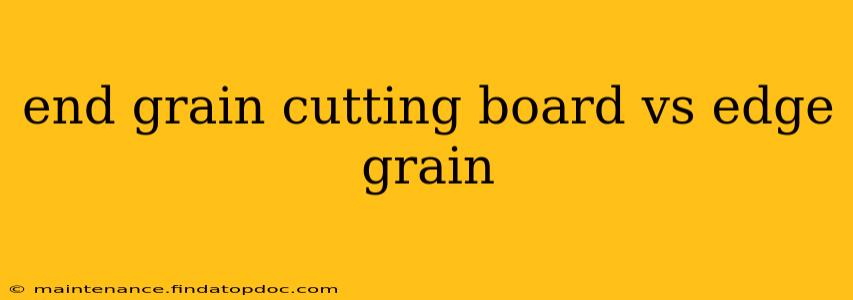Choosing the right cutting board can significantly impact your cooking experience and the longevity of your knives. Two popular types dominate the market: end-grain and edge-grain cutting boards. Understanding their differences is key to making an informed decision. This comprehensive guide explores the pros and cons of each, helping you determine which cutting board best suits your needs and budget.
What is an End Grain Cutting Board?
End-grain cutting boards are crafted with the wood's end grain (the cross-section of the tree) facing upwards. This means you're cutting across the tightly packed wood fibers. This unique construction offers superior knife protection and a more stable cutting surface.
Pros of End Grain Cutting Boards:
- Superior Knife Protection: The dense end grain significantly reduces knife blade dulling compared to edge-grain boards. The fibers are compressed, offering resistance and preventing the blade from catching or chipping.
- Self-Healing Properties: Minor cuts and scratches tend to close up naturally due to the wood's density and the way the fibers are oriented.
- More Comfortable Cutting Surface: The slightly yielding surface provides a more comfortable and less jarring experience for your hands and wrists during extended use.
- Longer Lasting: While more expensive initially, the superior knife protection and self-healing properties often translate to a longer lifespan.
Cons of End Grain Cutting Boards:
- Higher Cost: Due to the labor-intensive manufacturing process (often requiring more wood), end-grain boards typically command a higher price.
- More Prone to Water Damage: While generally more durable, end-grain boards can absorb more water if not properly cared for, leading to potential warping or bacterial growth.
- Heavier: The denser construction results in a heavier cutting board, making it less portable.
What is an Edge Grain Cutting Board?
Edge-grain cutting boards have the wood's long grain (the side of the tree) facing upwards. This means you are cutting along the wood grain. This construction is simpler and more common, resulting in a more affordable product.
Pros of Edge Grain Cutting Boards:
- Lower Cost: Generally less expensive than end-grain boards due to simpler construction and less material usage.
- Lighter Weight: Easier to handle and move around your kitchen.
- Easier to Clean: Their smooth surface tends to be easier to clean.
Cons of Edge Grain Cutting Boards:
- More Knife Damage: Cutting along the grain can lead to more blade dulling and potential chipping of the knife's edge.
- Less Durable: More prone to scratches and gouges that can accumulate over time and harbor bacteria.
- Less Comfortable Cutting Surface: The harder surface can be less comfortable for hands and wrists during long periods of chopping.
How Do I Choose Between End Grain and Edge Grain?
The best choice depends on your priorities:
- Prioritize Knife Protection and Longevity: Opt for an end-grain cutting board. The long-term investment in knife protection and board durability often outweighs the higher initial cost.
- Prioritize Budget and Convenience: An edge-grain cutting board is a more affordable and lighter option, suitable for occasional use.
- Consider Your Cutting Style: If you do a lot of heavy chopping, an end-grain board is the better choice. For lighter tasks, an edge-grain board may suffice.
What is the Difference in Maintenance?
Both end-grain and edge-grain cutting boards require proper care to maintain their quality and hygiene. Regular oiling is crucial for both types to prevent cracking and bacterial growth. Always hand-wash and thoroughly dry your cutting board after each use. Avoid prolonged exposure to water.
Are there other types of cutting boards?
Yes, besides end-grain and edge-grain cutting boards, there are also side-grain cutting boards and cutting boards made from other materials such as plastic and bamboo. Side-grain boards are essentially the same as edge-grain, just slightly different in the way the wood is arranged.
Which is better for professional chefs?
Professional chefs often prefer end-grain cutting boards for their superior knife protection and durability, which is crucial in a high-volume kitchen environment.
Which is better for home cooks?
Home cooks can choose either, depending on their budget and cutting habits. If budget is a concern, an edge grain cutting board would be a reasonable alternative. However, an end-grain cutting board offers a superior cutting experience in the long run.
By carefully considering these factors, you can select the cutting board that best meets your needs and enhances your culinary experience. Remember that proper care and maintenance are key regardless of the type of cutting board you choose.
